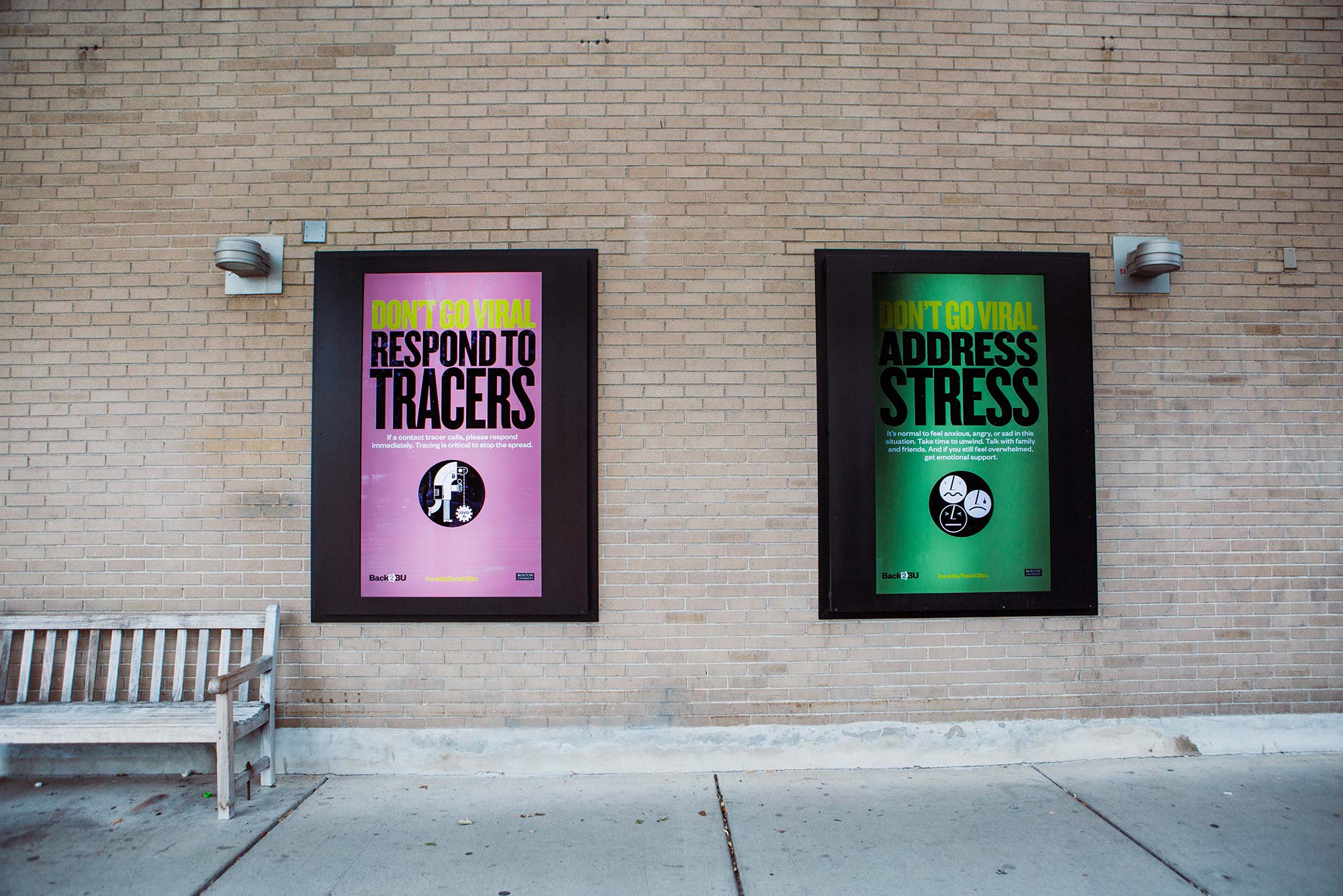Q&A: BU’s Contact Tracing System Explained

Contract tracing can help reduce onward transmission of COVID-19. It has been used successfully in Singapore, Taiwan, Hong Kong, and South Korea as part of their approach to controlling the spread of COVID-19 in their countries. Photo by Janice Checchio
Q&A: BU’s Contact Tracing System Explained
How it works, what it means for classroom time, what happens when you’re identified as a close contact
Students spending the fall semester on Boston University’s campus have much to learn in addition to their academic pursuits. Faculty, too, have had to quickly master a catalog of rules, protocols, and advisories put in place to control the spread of COVID-19. Most of the protocols, like what kind of mask to wear, how to socially distance, and how to work out at FitRec, are easy to understand. Then there is contact tracing—complicated, but every bit as important as all the other precautions.
“Contact tracing is an important part of a strategy for identifying close contacts of individuals infected with COVID-19 so that they can be quickly tested and placed in isolation if positive and in quarantine if not infected [but potentially incubating],” says Davidson Hamer, a School of Public Health professor of global health and medicine and a School of Medicine professor of medicine, a faculty member at BU’s National Emerging Infectious Diseases Laboratories, and a member of the University’s Medical Advisory Group. “This strategy can be used to help reduce onward transmission of COVID-19 and has been used successfully in Singapore, Taiwan, Hong Kong, and South Korea as part of their approach to control the spread of COVID-19 in their countries. Our model is based on the approach taken by the Massachusetts Department of Public Health and is based on Centers for Disease Control and Prevention [CDC] guidance.”
While the goal of contact tracing is simple—to identify people who may have been exposed to COVID-19—the process of contact tracing has been the subject of many questions put to University health officials. To answer some of the most frequently asked questions, BU Today spoke with Hannah Nichols, a Student Health Services nurse practitioner and the director of case management and contact tracing at Healthway.
Q&A
with Hannah Nichols
BU Today: Contact tracing seems to engender a lot of questions. Is there a simple way to explain how it works?
Hannah Nichols: Contact tracing can be confusing. For one thing, the process is different for students, for faculty and staff, and for those who are a close contact of a COVID-19 positive person.
BU Today: How did BU come up with its contact tracing process?
Hannah Nichols: Boston University’s contact tracing protocol is modeled off the World Health Organization, CDC, and Massachusetts Community Tracing Collaborative processes. Contact tracing scripts have been adapted with input from University academic programs and students to capture the day-to-day intricacies of student and professional life. In addition to identifying close contacts, BU contact tracers also obtain information about locations visited on campus and collaborate daily with BU’s Facilities Management & Operations and Environmental Health and Safety offices to inform critical cleaning and disinfecting efforts throughout the campus. Locations visited by people who test positive may be subject to additional cleaning.
BU Today: How do you define “close contact”?
Hannah Nichols: A close contact is someone who was within six feet of an infected person for at least 15 minutes starting from two days before symptom onset, or two days prior to the test date, if the individual has no symptoms.
BU Today: How do you know that people are being honest in their interviews with the contact tracers or that they are remembering the people they came in contact with?
Hannah Nichols: The contact tracers help the person walk through the days leading up to the illness in great detail in order to recall close contacts and locations visited. Protecting individual privacy helps to ensure people are being honest in their interviews.
BU Today: I’m in a classroom with students for three hours at a time—doesn’t this make me a close contact even if we are six feet away and wearing masks?
Hannah Nichols: There may be unique circumstances that require identification beyond close contacts and these decisions are made on a case-by-case basis.
BU Today: If I’m identified as a close contact, why do I have to quarantine? Can’t I just take a test, and if I test negative, go back to normal?
Hannah Nichols: The virus can develop between 2 to 14 days after exposure. Therefore, it is essential to quarantine for the full 14 days after exposure. The state of Massachusetts also requires quarantine for at least 14 days from the date of last exposure, regardless of a negative test result.
BU Today: How does BU’s contact tracing program interact with/share information with the contact tracing being done by the city and state? Is any information shared with the city and state?
Hannah Nichols: Healthway works closely with the Boston Public Health Commission and the Massachusetts Department of Public Health’s case investigation and contact tracing efforts in order to strengthen resources and not duplicate vital efforts.
BU Today: The University has decided that it will not notify faculty if a student in their class has tested positive. Why not?
Hannah Nichols: Contact tracing is dependent on the data the individual provides. Ensuring an individual’s right to privacy allows for productive and honest reporting of close contacts. In healthcare, health-related information is not disclosed by the healthcare workers or institution unless there is an immediate threat to someone’s safety. An individual is welcome to share their personal medical information with others.
BU Today: Is BU using an app or technology to supplement the manual contact tracing?
Hannah Nichols: We are using technology to support contact tracers in that we are providing contact tracers with a system that enables them to record the close contacts they identify and attributes of those close contacts, such as the location or event where the close contact occurred. This allows the creation of network diagrams to help identify potential clusters of transmission.
We are also working to provide contact tracers with basic information from BU information systems about potential close contacts, in order to aid the memory of individuals whose contacts are being traced and speed up the gathering of contact information for the close contacts. Potential close contacts we plan to provide include individuals associated with a student, such as roommates, teammates, faculty teaching courses they are attending, TAs, or classmates. It is important to note that these are only potential, not actual, close contacts.
We are not yet using or recommending an automated exposure notification app. There are several such apps, and they require installation on a broad percentage of smartphones in the community to be effective. We have not yet recommended such an app because their privacy and accuracy is still rapidly evolving, and the state of Massachusetts has not yet identified a primary platform that it will recommend. Since breadth and consistency of adoption is important for these apps to be effective, we do not want to go down a path with another app that could become counterproductive when the state chooses its direction.
Additional questions can be sent to healthwayhelp@bu.edu.

Comments & Discussion
Boston University moderates comments to facilitate an informed, substantive, civil conversation. Abusive, profane, self-promotional, misleading, incoherent or off-topic comments will be rejected. Moderators are staffed during regular business hours (EST) and can only accept comments written in English. Statistics or facts must include a citation or a link to the citation.